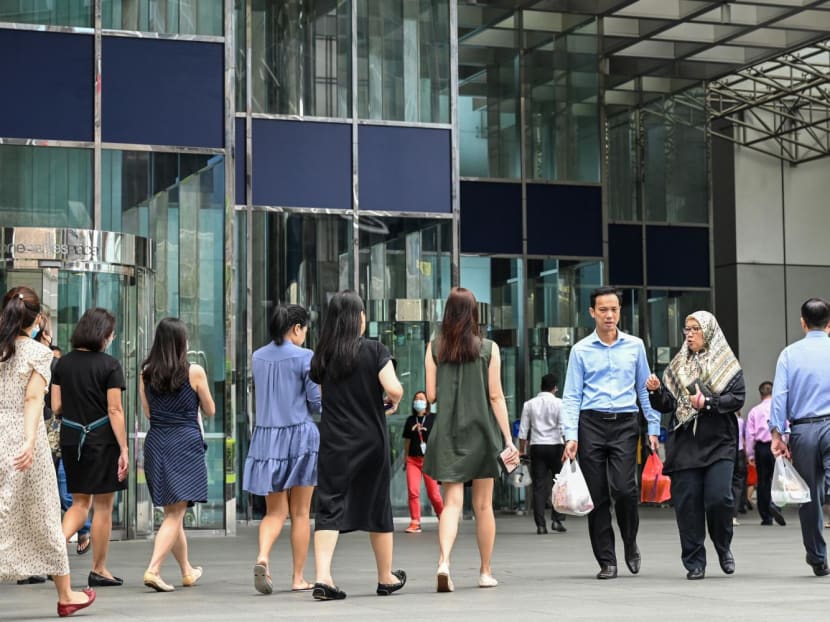Real median incomes dipped 2.3 per cent in 2023 due to high inflation, but expected to ease in 2024: MOM
SINGAPORE — With high inflation in 2023 eating into the spending power of Singapore residents, the real incomes for workers at the 20th percentile fell by 3 per cent compared with the same period last year, while that for median workers dipped by 2.3 per cent, even as nominal wages grew.

A scene at Singapore's financial district during lunchtime.
-
While nominal wages rose in 2023, real incomes fell for workers at the 20th and 50th percentiles due to high inflation, the Ministry of Manpower (MOM) said on Thursday
-
This fall in real incomes is expected to ease next year as inflation tapers off, said MOM
-
The authority on Thursday released an advance report of how Singapore’s labour market fared in the whole of 2023
-
MOM noted that over the past 10 years, real income growth has nevertheless remained positive and wage dispersion between the 20th and 50th percentile workers had narrowed, as the incomes of lower-wage workers rose faster than that of the median worker
SINGAPORE — With high inflation this year eating into the spending power of Singapore residents, the real incomes for workers at the 20th percentile fell by 3 per cent compared with the same period last year, while that for median workers dipped by 2.3 per cent, even as nominal wages grew.
However, the fall in real incomes is expected to ease next year as inflation tapers off, the Ministry of Manpower (MOM) said on Thursday (Nov 30) when it released an advance report of how Singapore’s labour market is expected to fare in the whole of 2023.
Core inflation is projected to be 4 per cent as a whole this year, and is expected to come in at 2.5 per cent to 3.5 per cent in 2024, based on the Monetary Authority of Singapore’s monetary policy statement published last month.
Excluding the impact of the increase in the Goods and Services Tax (GST) rate in January next year, core inflation for 2024 is forecast at 1.5 per cent to 2.5 per cent, the authority said.
MOM noted that over the past 10 years, real income growth has remained positive and wage dispersion between the 20th and 50th percentile workers had narrowed, as the incomes of lower-wage workers rose faster than that of the median worker.
The 20th percentile refers to the income level that divides the bottom 20 per cent of income earners from the rest. Median or 50th percentile refers to the income level at the middle of the income distribution that divides the bottom half of income earners from the upper half.
“While real income growth for the remainder of 2023 is likely to remain negative, we expect an improvement in real income growth in 2024 with inflation easing,” MOM said.
It added that government transfers such as the Workfare Income Supplement and the Assurance Package from the national budget helped individuals and households to better cope with higher costs arising from inflation. The Workfare Income Supplement tops up the salaries of low-income workers and their Central Provident Fund accounts to help them save for retirement.
Accounting for the Workfare Income Supplement and related payments, real income for the 20th percentile worker dropped 2.1 per cent year-on-year instead of 3 per cent.
Apart from real income, the report also found that the labour market remained tight, with unemployment and long-term unemployment rates falling for workers across occupational groups.
The annual release by MOM’s manpower research and statistics department is meant to provide early findings from the Comprehensive Labour Force Survey to be released next year.
OTHER KEY FINDINGS
The MOM report also found that employment rate for residents aged 15 and over declined to 66.2 per cent in 2023, from a historical high of 67.5 per cent in 2022.
When ranked against countries from the Organisation for Economic Co-operation and Development, Singapore’s employment rate ranked high — coming in fourth place, ahead of countries such as Switzerland, the United Kingdom and the United States.
Unemployment rates and long-term unemployment rates for professionals, managers, executives and technicians (PMETs) as well as non-PMETs improved in 2023.
Non-PMETs saw a larger decline in unemployment rate (from 4.4 per cent in 2022 to 3.6 per cent in 2023), compared to that for PMETs (from 2.6 per cent in 2022 to 2.4 per cent in 2023).
MOM added that the incidence of workers who are discouraged from seeking work remained stable and low at 0.4 per cent in 2023.
Time-related under-employment rate — defined as the percentage of time-related under-employed persons to employed persons — declined from 3.0 per cent in 2022 to 2.3 per cent in 2023, reaching the lowest in over a decade.
The rate measures the percentage of persons aged 15 years old and above who normally work part-time or less than 35 hours a week but are willing and available to engage in additional work.
The latest finding indicates that more part-time workers in 2023 compared to 2022 were able to have the work hours they want.
The proportion of employees in permanent jobs also rose to 90.5 per cent, which was comparable to the previous high in 2016, when 90.6 per cent of employees were in full-time work.
WHAT ECONOMISTS SAY
Mr Song Seng Wun, an economic consultant from financial service provider CGS-CIMB Securities, said that real incomes for lower-income and median workers could have dipped in the past few years due to the influence of external factors. These included the Covid-19 pandemic and supply disruptions arising from the Ukraine war, which could have led governments around the world to impose export bans.
These external disruptions are what likely caused food and general inflation to rise, he added.
Associate Professor Alwyn Lim from the Singapore Management University (SMU), whose research interests include economic sociology, said that employers may have been hesitant to increase workers’ salaries as well, due to their own increased operating costs, and income increases therefore did not keep pace with the rate of inflation.
He also said that one of the causes of inflation could be government payout measures, such as those introduced during the Covid-19 pandemic, which had the effect of increasing demand for goods and services in limited supply, thus resulting in higher prices.
Mr Song said that nominal incomes could have risen in Singapore due to government support rendered to businesses — which allowed companies to retain their workers and maintain a relatively tight labour force overall — thereby leading to spillover effects on income growth.
Schemes such as the Progressive Wage Model — which covers the food-and-beverage as well as the retail sectors — likely also played a part in lifting nominal wages this year, he added.
With inflation projected to moderate next year, the trend for real income could possibly reverse, the experts said.
Economist Chua Han Teng from DBS bank said: “In our view, 2024’s real income growth is likely to be better than in 2023.
“Moderating inflation would bite less from nominal income gains in a still uncertain economic environment that could soften labour demand”.
DBS’ headline inflation forecast for Singapore in 2024 is 3.5 per cent, while its forecast for core inflation is 3.1 per cent, Mr Chua added.
Mr Song said that if inflation rates fall below 4 per cent and global food prices continue to recede while “softer labour market conditions prevail”, there could be positive real wage growth, though it would be a modest increase.
Agreeing, Assoc Prof Lim from SMU said that while there may be some positive real income growth in 2024, he expects this to be “modest at best”.
He said that employers were unlikely to increase workers’ salaries to track inflation because of the cost constraints faced, and the alternative — which involves laying off workers — might be worse.
“Unless there is some new innovation sector or major productivity growth, it is unlikely that there will be above-average wage growth since Singapore has maintained high employment, meaning that there is no need for employers to fill positions with the promise of higher pay.
“Even sectors like technology or energy remain volatile. Given the uncertain economic outlook for the near future, wage growth will likely be moderate and real incomes will probably not keep pace with inflation.”











